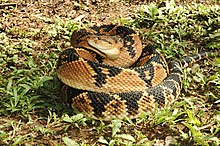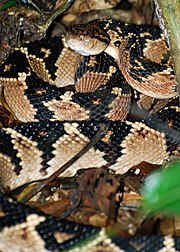| Lachesis muta | |
|---|---|

| |
| Conservation status | |
 Least Concern (IUCN 3.1) | |
| Scientific classification | |
| Domain: | Eukaryota |
| Kingdom: | Animalia |
| Phylum: | Chordata |
| Class: | Reptilia |
| Order: | Squamata |
| Suborder: | Serpentes |
| Family: | Viperidae |
| Genus: | Lachesis |
| Species: | L. muta |
| Binomial name | |
| Lachesis muta (Linnaeus, 1766) | |
| Synonyms | |
| |
Lachesis muta, also known as the Southern American bushmaster or Atlantic bushmaster, is a pit viper species found in South America, as well as the island of Trinidad in the Caribbean. Two subspecies are currently recognized, including the nominate subspecies described here.
Taxonomy
Two additional subspecies, L. m. melanocephala and L. m. stenophrys, had earlier been recognized. However, both were elevated to species level by Zamudio and Green in 1997 (see L. melanocephala and L. stenophrys).
Subspecies
| Subspecies | Taxon author | Common name | Geographic range |
|---|---|---|---|
| Lachesis muta muta | (Linnaeus, 1766) | South American bushmaster | Southeastern Colombia, eastern Ecuador, Peru, northern Bolivia, eastern and southern Venezuela, Trinidad, Guyana, Suriname, French Guiana and much of northern Brazil |
| Lachesis muta rhombeata | (Wied-Neuwied, 1824) | Atlantic Forest bushmaster | Coastal forests of southeastern Brazil (from southern Rio Grande do Norte to Rio de Janeiro). |
Description
Adults grow to an average of 2 to 2.5 m (6½-8 feet), although 3 m (10 feet) is not too unusual. The largest recorded specimen was 3.65 m (almost 12 feet) long, making the species the largest of all vipers and the longest venomous snake in the Western Hemisphere. Lachesis muta is the third longest venomous snake in the world, exceeded in length only by the king cobra and the black mamba. Weight in this species is estimated at an average of 3 to 5 kg (6.6 to 11.0 lb), somewhat less than the heaviest rattlesnakes (like the eastern diamondback rattlesnake) or Bitis vipers (such as the Gaboon viper and rhinoceros viper).
The head is broad and distinct from the narrow neck. The snout is broadly rounded. There is no canthus. A pair of small internasals is present, separated by small scales. The supraoculars are narrow. Other parts of the crown are covered with very small scales. Laterally, the second supralabial forms the anterior border of the loreal pit, while the third is very large. The eye is separated from the supralabials by 4-5 rows of small scales.
The body is cylindrical, tapered and moderately stout. Midbody there are 31-37 nonoblique rows of dorsal scales which are heavily keeled with bulbous tubercles and feebly imbricate. There are 200-230 ventral scales. The tail is short with 32-50 mainly paired subcaudals, followed by 13-17 rows of small spines and a terminal spine. Like most New World pit vipers, Lachesis muta exhibits defensive tail vibration behavior in response to potential predatory threats
The color pattern consists of a yellowish, reddish or grey-brown ground color, overlaid with a series of dark brown or black dorsal blotches that form lateral inverted triangles of the same color. The lateral pattern may be precisely or indistinctly defined, normally pale at the center.
Venom

Some reports suggest that this species produces a large amount of venom that is weak compared to some other vipers. Others, however, suggest that such conclusions are not accurate. These animals are badly affected by stress and rarely live long in captivity. This makes it difficult to obtain venom in useful quantities and good condition for study purposes. For example, Bolaños (1972) observed that venom yield from his specimens fell from 233 mg to 64 mg while they remained in his care. As the stress of being milked regularly has this effect on venom yield, it is reasoned that it may also affect venom toxicity. This may explain the disparity described by Hardy and Haad (1998) between the low laboratory toxicity of the venom and the high mortality rate of bite victims.
Brown (1973) gives the following LD50 values for mice: 1.5 mg/kg IV, 1.6–6.2 mg/kg IP, 6.0 mg/kg SC. He also notes a venom yield of 200–411 mg. The bushmaster's venom has proteolytic activity, which destroys and causes lesions in the tissue, anti-coagulant, which causes incoagulable blood, hemorrhagic and neurotoxic, that acts mainly on vagal stimulation. The symptoms are quite similar to those caused by Bothrops, at the site of the bite there is pain, edema, ecchymosis, skin necrosis, abscesses, vesicles and blisters. The main complications at the bite site include necrosis, compartment syndrome, secondary infections and functional deficit. The systemic effects are characterized by hypotension, dizziness, visual disturbances, bradycardia, abdominal pain, nausea, vomiting and diarrhea. Other manifestations are also similar to Bothrops, including systemic hemorrhage and kidney failure. In ilhéus, Bahia, Brazil, a 7-year-old boy was bitten when he left the house and stepped on one of these specimens, which then readily bit him; death was reported to have occurred approximately 15 minutes later. In 2005, in northwest Mato Grosso, a 5-year-old child also died, going into shock approximately 30 minutes after being bitten by a Lachesis muta and succumbing within 90 minutes.
Etymology
Lachesis is one of the three Fates in Greek mythology and was supposed to assign to man his term of life—something this species is certainly capable of doing. The species is similar in appearance to rattlesnakes and vibrates its tail vigorously when alarmed, but has no rattle and was therefore called mutus (later muta), which is Latin for "dumb" or "mute". However, when in the undergrowth, the tail actually makes quite a loud rustling noise.
Common names
Known as the mapepire zanana or mapepire grande (pronounced ma-pa(y)-PEE za-Na-na or ma-pa(Y)-PEE GRAN-dey) in Trinidad, surucucú in the Amazon Basin (surucucu in a large part of Brazil), shushúpe in Peru, and pucarara in Bolivia. In Venezuela the species is known as cuaima or cuaima piña. In Colombia it is known as verrugosa or verrugoso due to the warty look of its scales, and in Suriname as makasneki and makkaslang.
It is called ĩtsãi in the Kwaza language of Rondônia, Brazil.
In the Shawi language of Peru, it is called na’shi.
Distribution and habitat
L. muta is found in South America in the equatorial forests east of the Andes, and the island of Trinidad. The type locality is "Surinami" (Suriname). It occurs in primary and secondary forests; adjacent fields and cleared areas. In Trinidad it tends to prefer hilly and mountainous regions.
Diet
Bushmasters prey primarily on rats and mice. Birds and reptiles may occasionally be eaten. Spiny rats are favored prey items in Costa Rica. Rice rats and agoutis are other favored prey. Other prey items include porcupines, squirrels, opossums, squirrel monkeys, and frogs.
References
- Gutiérrez-Cárdenas, P., Rivas, G., Caicedo, J.R., Ouboter, P., Hoogmoed, M.S. & Murphy, J. 2021. Lachesis muta. The IUCN Red List of Threatened Species 2021: e.T62254A44946798. https://dx.doi.org/10.2305/IUCN.UK.2021-3.RLTS.T62254A44946798.en. Accessed on 16 January 2023.
- ^ McDiarmid RW, Campbell JA, Touré T (1999). Snake Species of the World: A Taxonomic and Geographic Reference, Volume 1. Washington, District of Columbia: Herpetologists' League. 511 pp. ISBN 1-893777-00-6 (series). ISBN 1-893777-01-4 (volume).
- Lang, Kirsty (6 October 2013). "Trying to save the heat-seeking Atlantic bushmaster". BBC News. Retrieved 7 October 2013.
- ^ "Lachesis muta". Integrated Taxonomic Information System. Retrieved 25 October 2006.
- ^ Mehrtens JM (1987). Living Snakes of the World in Color. New York: Sterling Publishers. 480 pp. ISBN 0-8069-6460-X.
- ^ United States Navy (1991). Poisonous Snakes of the World. New York: U.S. Government / Dover Publications Inc. 203 pp. ISBN 0-486-26629-X.
- Allf, B. C., Durst, P. A., & Pfennig, D. W. (2016). Behavioral plasticity and the origins of novelty: the evolution of the rattlesnake rattle. The American Naturalist, 188(4), 475-483.
- Lachesis muta, The Silent Fate at South American Pictures. Accessed 26 October 2006.
- Ripa D (2001). "Bushmasters and the Heat Strike" at VenomousReptiles.org Archived 2008-04-09 at the Wayback Machine. Accessed 26 October 2006.
- Brown JH (1973). Toxicology and Pharmacology of Venoms from Poisonous Snakes. Springfield, Illinois: Charles C. Thomas. 184 pp. LCCCN 73-229. ISBN 0-398-02808-7.
- Pinho, F. M. O.; Pereira, I. D. (January–March 2001). "Ofidismo". Revista da Associação Médica Brasileira (in Portuguese). 47 (1): 24–29. doi:10.1590/S0104-42302001000100026. ISSN 0104-4230. PMID 11340447.
- Borges, Célio Campos; Sadahiro, Megumi; Santos, Maria Cristina dos (November–December 1999). "Aspectos epidemiológicos e clínicos dos acidentes ofídicos ocorridos nos municípios do Estado do Amazonas". Revista da Sociedade Brasileira de Medicina Tropical (in Portuguese). 32 (6): 637–646. doi:10.1590/S0037-86821999000600005. ISSN 0037-8682.
- Rodrigo C. G. de Souza; Ana Paula Bhering Nogueira; Tiago Lima; João Luiz C. Cardoso (2007). "The Enigma of the North Margin of the Amazon River : Proven Lachesis Bites in Brazil, Report of Two Cases, General Considerations about the Genus and Bibliographic Review" (PDF). Bull. Chicago Herp. Soc. 42 (7): 105–115. Retrieved 22 March 2022.
- Rodrigo (2 January 2011). "Núcleo Serra Grande: Sobre o tamanho (verdadeiro) de Lachesis". Núcleo Serra Grande. Retrieved 2020-11-17.
- Gotch AF (1986). Reptiles — Their Latin Names Explained. Poole, United Kingdom: Blandford Press. 176 pp. ISBN 0-7137-1704-1.
- Mendes, John (1986). Cote ce Cote la: Trinidad & Tobago Dictionary. Arima, Trinidad. p. 95.
- ^ "List of Snakes of Trinidad and Tobago" Archived 2006-08-08 at the Wayback Machine at Republic of Trinidad and Tobago Biodiversity Clearing House Archived 2012-12-21 at archive.today. Accessed 25 October 2006.
- Campbell JA, Lamar WW (2004).
- Manso, Laura Vicuña Pereira. 2013. Dicionário da língua Kwazá. M.A. dissertation. Guajará-Mirim: Federal University of Rondônia.
- Rojas-Berscia, Luis Miguel. 2019. From Kawapanan to Shawi: Topics in language variation and change. Doctoral dissertation, Radboud University Nijmegen.
- Herklots GAC (1961). The Birds of Trinidad and Tobago. London: Collins. p. 10.
- Adams, Ashely. "Lachesis muta (South American Bushmaster)". Animaldiversity.org. Retrieved 31 May 2022.
- "Lachesis muta (Bushmaster or Mapepire Zanana)" (PDF). Sta.uwi.edu. Retrieved 31 May 2022.
- ^ "Amazonian Bushmaster (Lachesis muta)".
Further reading
- Bolaños R (1972). "Toxicity of Costa Rican snake venoms for the white mouse". American Jour. Trop. Med. Hyg. 21: 360–363.
- Hardy DL Sr, Haad JJS (1998). "A review of venom toxinology and epidemiology of envenoming of the bushmaster (Lachesis) with report of a fatal bite". Bull. Chicago Herp. Soc. 33(6): 113–123.
- Linnaeus C (1766). Systema naturæ per regna tria naturæ, secundum classes, ordines, genera, species, cum characteribus, differentiis, synonymis, locis. Tomus I. Editio Duodecima, Reformata . Stockholm: L. Salvius. 532 pp. (Crotalus mutus, new species, p. 373). (in Latin).
- O'Shea M (2005). Venomous Snakes of the World. Princeton, New Jersey: Princeton University Press. 160 pp. ISBN 0-691-12436-1.
- Zamudio KR, Greene HW (1997). "Phylogeography of the bushmaster (Lachesis muta: Viperidae): implications for neotropical biogeography, systematics and conservation". Biological Journal of the Linnean Society 62: 421–442. PDF at Cornell University, Department of Ecology and Evolutionary Biology. Accessed 26 October 2006.
External links
- Lachesis muta at the Reptarium.cz Reptile Database. Accessed 12 December 2007.
- Ripa Ecologica. Accessed 26 October 2006.
| Taxon identifiers | |
|---|---|
| Lachesis muta | |
| Crotalus mutus | |
- IUCN Red List least concern species
- Lachesis (genus)
- Reptiles of Guyana
- Snakes of Brazil
- Reptiles of Ecuador
- Reptiles of Peru
- Reptiles of Bolivia
- Reptiles of Venezuela
- Reptiles of Suriname
- Reptiles of French Guiana
- Reptiles of Trinidad and Tobago
- Reptiles of Colombia
- Snakes of the Caribbean
- Taxa named by Carl Linnaeus
- Venomous snakes
- Reptiles described in 1766